
During August 2011 it was announced that excavation had begun on a prehistoric kistvaen that had been discovered on Whitehorse Hill 10 years ago. The Dartmoor Preservation website announced that ‘The site was first discovered in 2001 by Joe Turner when the western edge of the cist was exposed as its end stone fell out of the peat hag; this most probably was caused by the weathering away of the peat. There was no previous record of it‘. Actually that is not correct, I recently received an email from Rolland Harris which pointed out that a kist is in fact shown as being on Whitehorse Hill on the map of John Chudleigh’s which was printed in 1892 as can be seen below:
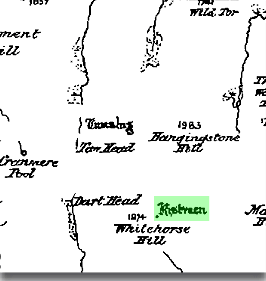
After several attempts to get the monument scheduled it was decided by the Dartmoor National Park Authority to sanction the excavation before vital evidence was lost. What made this particular kist so important was the fact that it had been covered by peat and therefore undisturbed. In turn this provided the possibility that if there were any remains they would still be insitu unlike the majority of Dartmoor kists which overtime had been robbed (see The Tomb Raiders and also The Despoilers). Aside from the kistvaens that had been looted for mythical treasure many had also been investigated by The Dartmoor Exploration Committee although the last of these investigations was well over 100 years ago. This was what made this current excavation so exciting, the very fact that the monument had been protected by the peat and therefore undisturbed and also that modern archaeological techniques could be used. The work was carried out by experts from Cornwall Council’s historic environment projects team, with assistance from English Heritage and specialists from the University of Plymouth. There were several aims of the excavation; to examine any pollen, insects or peat in order to establish what the surrounding landscape was when the kist was built, to search for artefacts that may give an indication of burial rituals, possible trade items and an indication of status. The kistvaen was located on the highest part of Whitehorse Hill at Ordnance Survey grid reference SX 6172 8547.
The highest point on Whitehorse Hill stands at 602m and for centuries it has been known for peat cutting and being a trans moor trackway via peat passes for livestock and huntsmen. As far as other known prehistoric monuments in the area go there simply are none which again makes this particular kistvaen an exception. The location within the physical landscape places the site on top of the hill at a height of around 200m. There are four watercourses that rise around the hill. to the north west (The Taw), the north east (The Wallabrook), the south east (The Great Varracombe) and to the east (The East Dart). Whether or not this has any significance as to the location of the kist is unknown but either way it makes for a spectacular burial site.
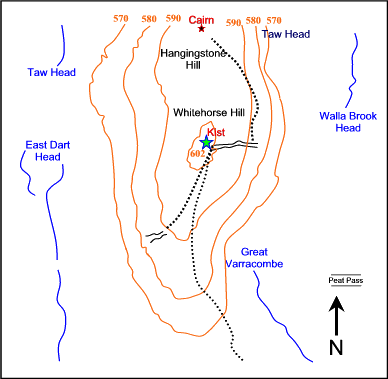
The description of the monument as given by The Devon Historic Environment Record is as follows:
“The monument includes a cist situated near the summit of Whitehorse Hill. The cist was, until 2001, visible in the edge of an irregularly shaped island of peat standing above its surroundings. Only the western edge of the cist was exposed, the remainder, including the cist’s original contents, being sealed beneath peat deposits. The cist measures 0.3 meters deep by 0.4 meters wide and its capstone remains in its original position. Early in 2001 a protective drystone wall measuring 3.0 meters long by 0.9 meters high was built in front of the western edge of the cist, which as a result is no longer visible. The stone cist is 0.6 meters long internally. The eastern end stone, the southern side stones and the capstone appear to be in situ but the northern side stone leans inward and the west end stone has collapsed,” (online source 2011).
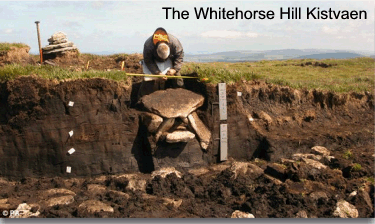
The Mail Online, 15th November 2011
Unfortunately I can find no reference as to the orientation of the kistvaen but it would be interesting to known if it follows the Dartmoor ‘norm’ of a lengthwise direction of between north and west?
The 2011 excavation was completed on the 12th of August and all the evidence was then taken away for further investigation. On the 15th of November 2011 the media exploded with spectacular headlines regarding the early findings of the investigation team. The Daily Mail even hailed the result as being ‘one of the most important archaeological discoveries of the century‘ which may be so in Dartmoor terms but I am sure this claim could be refuted on a global perspective. It appears that the finds were as promising as originally hoped and certainly were unique in modern day discoveries. Inside the burial chamber floor had a mat placed upon it which was made from plant material. On top of this was placed some kind of thin leather and textile object which in turn had an animal hide or fur inside which had been placed cremated human bone and burnt textile. At one end of the animal hide/fur was a finely stitched woven bag or basket that contained a mixture of shale disc and amber spherical beads (totalling around 100 in number) and a circular textile band. Two wooden stakes were also recovered from the kistvaen which as far a grave goods go are quite unusual. The entire deposits were then taken away to a Wiltshire conservation lab for further detailed examination when it is hoped that pollen analysis etc will be revealed along with a firm date of its construction, (already estimated to be 4,000 years ago). The Dartmoor National Park Authority have said that at some point they intend to restore the kistvaen and rebuilt it at its original location. This has now been completed as can be seen from the photograph below which was kindly sent to me by Dave Martin:
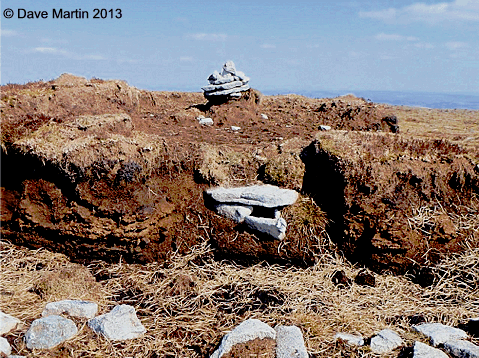
It has been suggested that the practice of cremation became popular from around 1500 BC and lasted through to around 1000 BC, (Taylor, p.39). This would then roughly coincide with the early estimated age of the kist being constructed around 4,000 years ago. There have been previous discoveries of the same period (although not on Dartmoor) where the remains have been wrapped in fur/hide bundles held together with bone/metal awls. Another common burial practice of this period was to place the fur/hide bundles in a beaker/urn but there is no mention of pottery sherds being found on Whitehorse Hill which is somewhat puzzling. Whilst in the Late Bronze Age the practice of cremation continued the ashes were simply deposited in shallow pits without a pottery vessel, although they may have been wrapped in perishable materials. Would this then point to a late Bronze Age burial as opposed to an earlier one?
All being well, the full details will be made available once the investigation is completed unlike some archaeological reports, and at a sensible price. But just from the bare facts given to the media there are some conclusions to be made, for instance there can be no doubt that trading was taking place. Shale and amber do not occur locally on Dartmoor and therefore must have been imported from another region and so one can assume it was as a trade or gift. This in turn implies some interaction with other tribes or traders from whence the goods came. It can also be suggested that this was a high status internment due to the prominent location of the site, the fact that there is no other nearby prehistoric monuments and possibly by the grave goods. The two wooden stakes should also enable the team to establish whether flint or bronze tools were used to sharpen them. Again this may well indicate trade as flint is not naturally found on Dartmoor as well as indicating how advanced technology was on the moor. But as with any such investigation there are usually as many questions arising than answers like; is this a unique peat style burial, are there others waiting to be discovered, what was the significance of the arrangement of the artefacts, what was the significance of the animal fur/hide, etc, etc? Hopefully I will be able to add more to this page whenever the report comes into the public domain.
February 2013
Some preliminary findings have been made public regarding the grave goods in the kist which are now being described as, “the national park’s most important archaeological finds ever,” and “the first organic remains found on Dartmoor.” The cremated remains have now been established as belonging to a “young man or woman” which currently does not say much. Under the guidance of head conservator Helen Williams the woven bag was carefully opened to reveal a number of beads along with wooden ear studs and a single amber bead. Clearly there is a great deal of further work to be done on the artefacts which will reveal more vital evidence for Bronze Age life on Dartmoor. Once the work has been completed it is intended that the finds will be part of an exhibition in Plymouth Museum sometime next year.
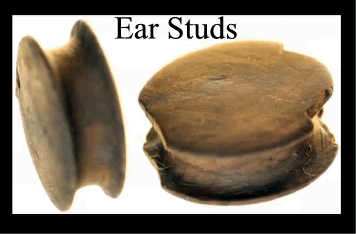 |
 |
On the 7th of February 2014 BBC South West aired a programme called ‘Mystery of the Moor’ in which further developments of the conservators work was reveal – more details – HERE
On the 8th of September 2014 it was announced that the pelt in which the grave goods were wrapped belonged to a Brown Bear – more details – HERE

Taylor, A. 2001 Burial Practices in Early England, Gloucestershire: Tempus Publishing.
Chudleigh, J. 1987 An Exploration of Dartmoor’s Antiquities, Kent: John Pegg Publishing.
 Legendary Dartmoor The many aspects past and present of Dartmoor
Legendary Dartmoor The many aspects past and present of Dartmoor

I would like you to know how much pleasure I derive from your website. I am a Janner whose family once farmed at Lovaton. My family left in 1953 when my father began his teaching career in Portsmouth. We maintained contacts on the Moor through friends who farmed at Goodameavy and family.
I visit Datmoor on an annual basis and wanted to retire there. Unfortunately. this was it to be, but I am able to relive the many happy times I spent there as a child and in successive holidays since.
Legendary Dartmoor keeps me in touch with what I regard as my roots and I owe this to you. So I thank you most sincerely.
Dianne
r left